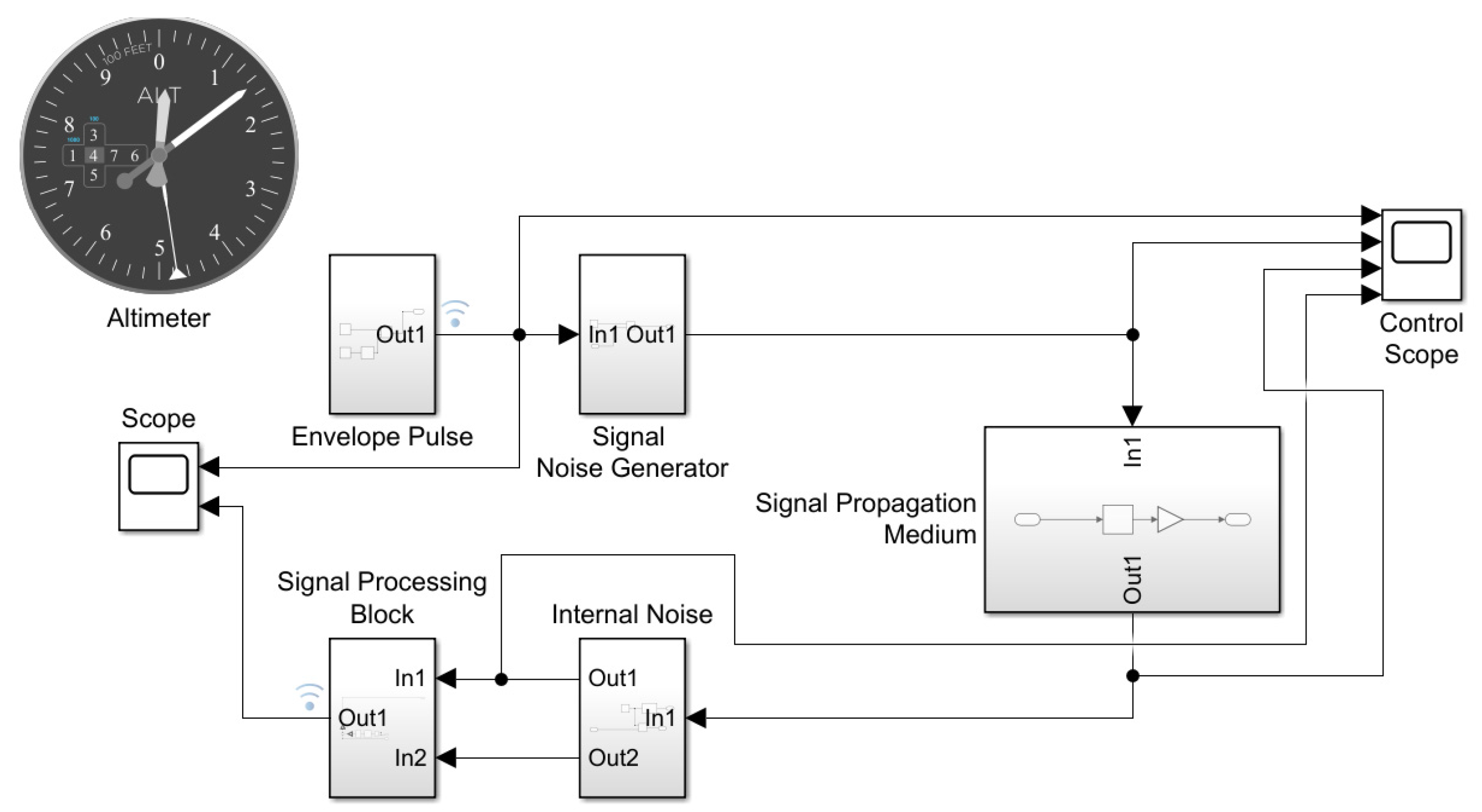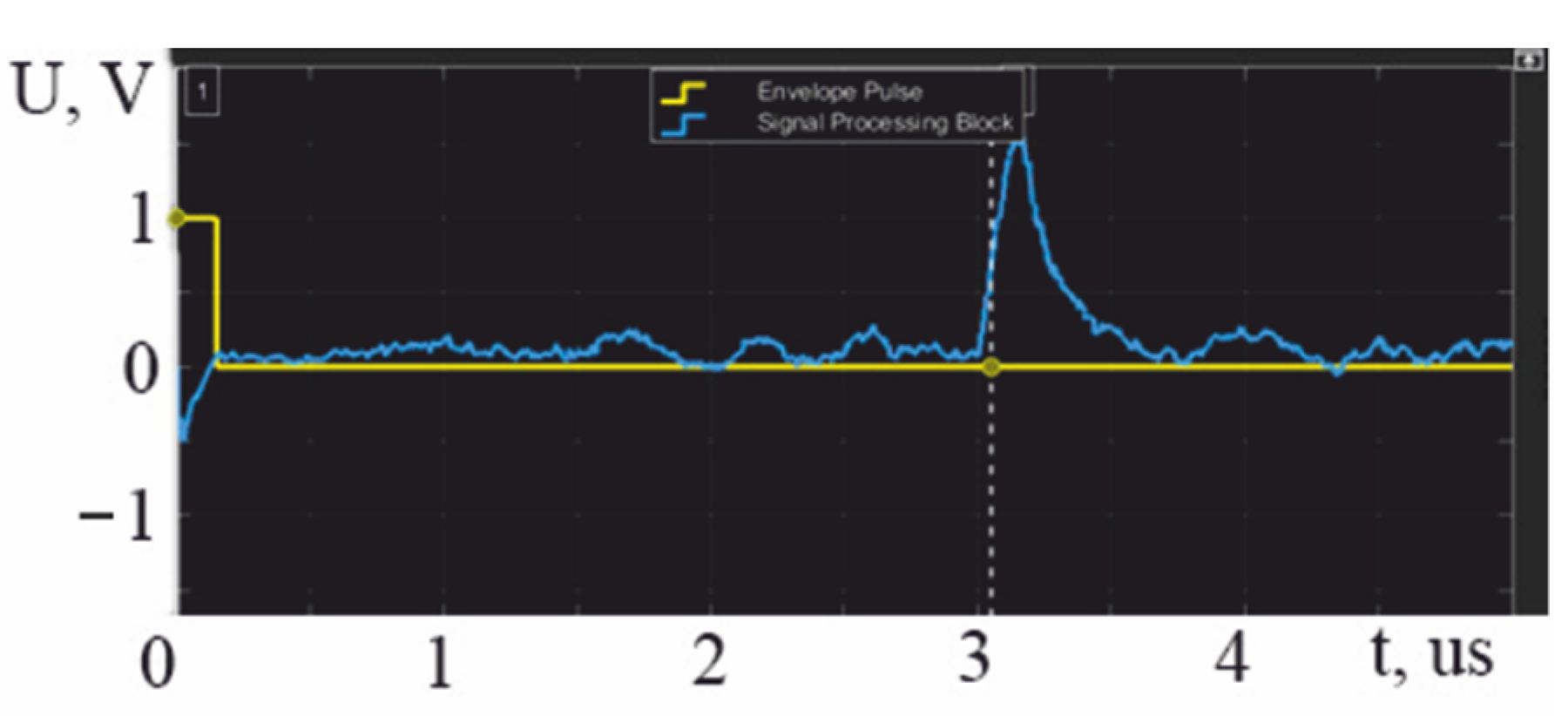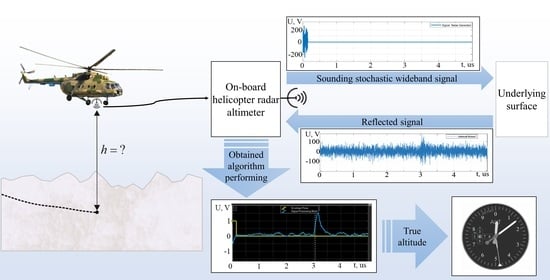Signal Processing Algorithm for Monopulse Noise Noncoherent Wideband Helicopter Altitude Radar
Abstract
:1. Introduction
2. Materials and Methods
3. Results
3.1. Delay Time Estimation Algorithm Synthesis
- (1)
- The amplitude–phase current distribution in the antenna aperture is uniform. Then the radiation pattern of the antenna in the coordinates of the underlying surface can be represented by an expression
- (2)
- The function for most real surfaces is described by polynomials, but for the interpretation of the algorithm it is sufficient to consider it as a constant, i.e., ;
- (3)
- The range of operating frequencies is limited by the function , which can be considered uniformly passable in the frequency range from to :
- (4)
- Let the radio pulse envelop be uniform, then
3.2. Simulation Results
4. Discussion
5. Conclusions
Author Contributions
Funding
Institutional Review Board Statement
Informed Consent Statement
Data Availability Statement
Conflicts of Interest
References
- Chen, M.; Zhang, Y.; Chen, Y. Review on civil aviation safety investment research. In Proceedings of the 2016 11th International Conference on Reliability, Maintainability and Safety (ICRMS), Hangzhou, China, 26–28 October 2016; pp. 1–5. [Google Scholar]
- Lungu, M.; Lungu, R. Complete landing autopilot having control laws based on neural networks and dynamic inversion. In Proceedings of the 2017 18th International Carpathian Control Conference (ICCC), Sinaia, Romania, 28–31 May 2017; pp. 17–22. [Google Scholar]
- Watkins, D.; Gallardo, G.; Chau, S. Pilot Support System: A Machine Learning Approach. In Proceedings of the 2018 IEEE 12th International Conference on Semantic Computing (ICSC), Laguna Hills, CA, USA, 31 January–2 February 2018; pp. 325–328. [Google Scholar]
- Bolanakis, D.E. MEMS barometers and barometric altimeters in industrial, medical, aerospace, and consumer applications. IEEE Instrum. Meas. Mag. 2017, 20, 30–55. [Google Scholar] [CrossRef]
- Kai, L.; Jun-Jie, L.; Jing, W.; Xiao-Jun, W. Research on Augmented Reality Technology of Heli-copter Aided Navigation Based on Lidar. In Proceedings of the 2021 IEEE 7th International Conference on Virtual Reality (ICVR), Foshan, China, 20–22 May 2021; pp. 373–379. [Google Scholar]
- Zhao, J.; Li, Y.; Hu, D.; Pei, Z. Design on altitude control system of quad rotor based on laser radar. In Proceedings of the 2016 IEEE International Conference on Aircraft Utility Systems (AUS), Beijing, China, 8–14 October 2016; pp. 105–109. [Google Scholar]
- Brockers, R. Autonomous Safe Landing Site Detection for a Future Mars Science Helicopter. In Proceedings of the 2021 IEEE Aerospace Conference (50100), Big Sky, MT, USA, 6–13 March 2021; pp. 1–8. [Google Scholar]
- Rahman, A.M.; Hossain, S.; Tuku, I.J.; Hossam-E-Haider, M.; Amin, M.S. Feasibility study of GSM network for tracking low altitude helicopter. In Proceedings of the 2016 3rd International Conference on Electrical Engineering and Information Communication Technology (ICEEICT), Dhaka, Bangladesh, 22–24 September 2016; pp. 1–8. [Google Scholar]
- Videmsek, A.; de Haag, M.U.; Bleakley, T. Evaluation of RADAR altimeter-aided GPS for precision approach using flight test data r. In Proceedings of the Digital Avionics Systems Conference (DASC), San Diego, CA, USA, 8–12 September 2019; pp. 1–10. [Google Scholar]
- Liu, B.; Meng, Z.; Zhou, Y. Nonlinear path following for unmanned helicopter. In Proceedings of the IEEE International Conference on Information and Automation, Macau, China, 18–20 July 2017; pp. 737–743. [Google Scholar]
- Chen, Y.; Wang, C.; Zeng, W.; Wu, Y. Horizontal Nonlinear Path Following Guidance Law for a Small UAV with Parameter Optimized by NMPC. IEEE Access 2021, 9, 127102–127116. [Google Scholar] [CrossRef]
- Ragi, S.; Mittelmann, H.D.; Zhou, Y. Mixed-integer nonlinear programming formulation of a UAV path optimization problem. In Proceedings of the 2017 American Control Conference (ACC), Seattle, WA, USA, 24–26 May 2017; pp. 406–411. [Google Scholar]
- 686-2017—IEEE Standard for Radar Definitions; IEEE: New York, NY, USA, 2017; pp. 1–54.
- Madhupriya, G.; Lavanya, K.S.; Vennisa, V.; Raajan, N.R. Implementation of Compressed Wave Pulsed Radar Altimeter in Signal Processing. In Proceedings of the 2019 International Conference on Computer Communication and Informatics (ICCCI), Coimbatore, India, 23–25 January 2019; pp. 1–5. [Google Scholar]
- Li, Y.; Hoogeboom, P.L.; Dekker, P.L.; Mok, S.-H.; Guo, J.; Buck, C. CubeSat Altimeter Constellation Systems: Performance Analysis and Methodology. IEEE Trans. Geosc. Rem. Sens. 2022, 60, 1–19. [Google Scholar] [CrossRef]
- Mogyla, A.; Kantsedal, V. Estimation of the Parameters of the Stochastic Probing Radio Signal Reflected by the Target. In Proceedings of the 2020 IEEE Ukrainian Microwave Week (UkrMW), Kharkiv, Ukraine, 22–27 June 2020; pp. 379–383. [Google Scholar]
- Ravenscroft, B.; Blunt, S.D.; Allen, C.; Martone, A.; Sherbondy, K. Analysis of spectral notching in FM noise radar using measured interference. In Proceedings of the International Conference on Radar Systems (Radar 2017), Belfast, UK, 23–26 October 2017; pp. 1–6. [Google Scholar]
- Wasserzier, C.; Wojaczek, P.; Cristallini, D.; Worms, J.; O’Hagan, D. Doppler-Spread Clutter Suppression in Single-Channel Noise Radar. In Proceedings of the 2019 International Radar Conference (RADAR), Toulon, France, 23–27 September 2019; pp. 1–4. [Google Scholar]
- Zhang, L.; Kuang, Q.; Chang, M.; Zhang, D. A 10-GS/s Sample and Hold System for High-Speed Time-Interleaved ADC. In Proceedings of the 2018 Eighth International Conference on Instrumenta-tion & Measurement, Computer, Communication and Control (IMCCC), Harbin, China, 19–21 July 2018; pp. 705–708. [Google Scholar]
- Genschow, D.; Kloas, J. Evaluation of a UWB radar interface for low power radar sensors. In Proceedings of the 2015 European Radar Conference (EuRAD), Paris, France, 9–11 September 2015; pp. 321–324. [Google Scholar]
- Wang, D. A Gm-Compensated 46–101 GHz Broadband Power Amplifier for High-Resolution FMCW Radars. In Proceedings of the 2021 IEEE International Symposium on Circuits and Systems (ISCAS), Daego, Korea, 22–28 May 2021; pp. 1–5. [Google Scholar]
- Rachid, E.A.; Farha, R.M. Ultra-wideband: Very simple printed antennas with Windows in K, Ka and Q bands. In Proceedings of the 2016 IEEE Conference on Antenna Measurements & Applications (CAMA), New York, NY, USA, 23–27 October 2016; pp. 1–4. [Google Scholar]
- Tarchi, D.; Lukin, K.; Fortuny-Guasch, J.; Mogyla, A.; Vyplavin, P.; Sieber, A. SAR Imaging with Noise Radar. IEEE Trans. Aerosp. Electron. Syst. 2010, 46, 1214–1225. [Google Scholar] [CrossRef]
- Ostroumov, I.; Kuzmenko, N.; Sushchenko, O.; Pavlikov, V.; Zhyla, S.; Solomentsev, O.; Zaliskyi, M.; Averyanova, Y.; Tserne, E.; Popov, A.; et al. Modelling and simulation of DME navigation global service volume. Adv. Space Res. 2021, 68, 3495–3507. [Google Scholar] [CrossRef]
- Pavlikov, V.; Belousov, K.; Zhyla, S.; Tserne, E.; Shmatko, O.; Sobkolov, A.; Vlasenko, D.; Kosharskyi, V.; Odokiienko, O.; Ruzhentsev, M. Radar imaging complex with sar and asr for aerospace vechicle. Radioel. Comp. Syst. 2021, 3, 63–78. [Google Scholar] [CrossRef]
- Pavlikov, V.; Volosyuk, V.; Zhyla, S.; Tserne, E.; Shmatko, O.; Sobkolov, A. Active-Passive Radar for Radar Imaging from Aero-space Carriers. In Proceedings of the 2016 IEEE EUROCON 2021—19th International Conference on Smart Technologies, Lviv, Ukraine, 6–8 July 2021; pp. 18–24. [Google Scholar]
- Zhyla, S.; Volosyuk, V.; Pavlikov, V.; Ruzhentsev, N.; Tserne, E.; Popov, A.; Shmatko, O.; Havrylenko, O.; Kuzmenko, N.; Dergachov, K.; et al. Statistical synthesis of aerospace radars structure with optimal spatio-temporal signal processing, extended observation area and high spatial resolution. Radioel. Comp. Syst. 2022, 1, 178–194. [Google Scholar] [CrossRef]
- Volosyuk, V.; Kravchenko, V. Theory of Radio-Engineering Systems of Remote Sensing and Radar; Fizmatlit: Moscow, Russia, 2008. [Google Scholar]
- Compact Radar Altimeter. Available online: https://electronics.leonardo.com/documents/16277707/18391547/Compact+Radar+Altimeter+%28MM09113%29_LQ.pdf (accessed on 18 March 2022).
- Radar Altimeter. Available online: https://www.freeflightsystems.com/blog/product/radar-altimeters/ (accessed on 25 March 2022).
- Arslan, S.; Yıldırım, B.S. A Broadband Microwave Noise Generator Using Zener Diodes and a New Technique for Generating White Noise. IEEE Microw. Wirel. Compon. Lett. 2018, 28, 329–331. [Google Scholar] [CrossRef]
- Pritsker, D.; Cheung, C.; Neoh, H.S.; Nash, G. Wideband Programmable Gaussian Noise Generator on FPGA. In Proceedings of the 2019 IEEE National Aerospace and Electronics Conference (NAECON), Dayton, OH, USA, 15–19 July 2019; pp. 412–415. [Google Scholar]
- Kravchenko, V.; Kutuza, B.; Volosyuk, V.; Pavlikov, V.; Zhyla, S. Super-resolution SAR imaging: Optimal algorithm synthesis and simulation results. In Proceedings of the 2017 Progress in Electromagnetics Research Symposium—Spring (PIERS), St. Petersburg, Russia, 22–25 May 2017; pp. 419–425. [Google Scholar]
- Pavlikov, V.; Zhyla, S.; Odokienko, O. Structural optimization of Dicke-type radiometer. In Proceedings of the 2016 II International Young Scientists Forum on Ap-plied Physics and Engineering (YSF), Kharkiv, Ukraine, 10–14 October 2016; pp. 171–174. [Google Scholar]
- Volosyuk, V.; Zhyla, S.; Pavlikov, V.; Ruzhentsev, N.; Tserne, E.; Popov, A.; Shmatko, O.; Dergachov, K.; Havrylenko, O.; Ostroumov, I.; et al. Optimal Method for Polarization Selection of Stationary Objects against the Background of the Earth’s Surface. Int. J. Electron. Telecommun. 2022, 68, 83–89. [Google Scholar]
- Tsopa, A.I.; Ivanov, V.K.; Leonidov, V.I.; Maleshenko, Y.I.; Pavlikov, V.V.; Ruzhentsev, N.V.; Zarudniy, A.A. The research program of millimetric radio waves attenuation characteristics on perspective communication lines of Ukraine. In Proceedings of the 2016 13th International Conference on Modern Probems of Radio Engineering, Telecommunications and Computer Science (TCSET), Lviv, Ukraine, 23–26 February 2016; pp. 638–642. [Google Scholar]
- Pavlikov, V.V.; Volosyuk, V.K.; Zhyla, S.S.; Van, H.N. Active Aperture Synthesis Radar for High Spatial Resolution Imaging. In Proceedings of the 2018 9th International Conference on Ultrawideband and Ultrashort Impulse Signals (UWBUSIS), Odessa, Ukraine, 4–7 September 2018; pp. 252–255. [Google Scholar]
- Astola, J.T.; Egiazarian, K.O.; Khlopov, G.I.; Khomenko, S.I.; Kurbatov, I.V.; Morozov, V.Y.; Totsky, A.V. Application of Bispectrum Estimation for Time-Frequency Analysis of Ground Surveillance Doppler radar Echo Signals. IEEE Trans. Instrum. Meas. 2008, 57, 1949–1957. [Google Scholar] [CrossRef]




Publisher’s Note: MDPI stays neutral with regard to jurisdictional claims in published maps and institutional affiliations. |
© 2022 by the authors. Licensee MDPI, Basel, Switzerland. This article is an open access article distributed under the terms and conditions of the Creative Commons Attribution (CC BY) license (https://creativecommons.org/licenses/by/4.0/).
Share and Cite
Volosyuk, V.; Pavlikov, V.; Zhyla, S.; Tserne, E.; Odokiienko, O.; Humennyi, A.; Popov, A.; Uruskiy, O. Signal Processing Algorithm for Monopulse Noise Noncoherent Wideband Helicopter Altitude Radar. Computation 2022, 10, 150. https://doi.org/10.3390/computation10090150
Volosyuk V, Pavlikov V, Zhyla S, Tserne E, Odokiienko O, Humennyi A, Popov A, Uruskiy O. Signal Processing Algorithm for Monopulse Noise Noncoherent Wideband Helicopter Altitude Radar. Computation. 2022; 10(9):150. https://doi.org/10.3390/computation10090150
Chicago/Turabian StyleVolosyuk, Valeriy, Volodymyr Pavlikov, Simeon Zhyla, Eduard Tserne, Oleksii Odokiienko, Andrii Humennyi, Anatoliy Popov, and Oleh Uruskiy. 2022. "Signal Processing Algorithm for Monopulse Noise Noncoherent Wideband Helicopter Altitude Radar" Computation 10, no. 9: 150. https://doi.org/10.3390/computation10090150





